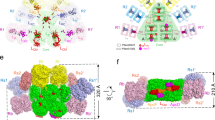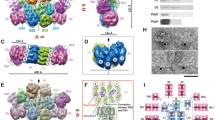Abstract
Phycobilisome (PBS) complexes are massive light-harvesting apparati in cyanobacteria that capture and funnel light energy to the photosystem. PBS complexes are dynamically degraded during nutrient deprivation, which causes severe chlorosis, and resynthesized during nutrient repletion. PBS degradation occurs rapidly after nutrient step down, and is specifically triggered by non-bleaching protein A (NblA), a small proteolysis adaptor that facilitates interactions between a Clp chaperone and phycobiliproteins. Little is known about the mode of action of NblA during PBS degradation. In this study, we used chemical cross-linking coupled with LC-MS/MS to investigate the interactions between NblA and phycobiliproteins. An isotopically coded BS3 cross-linker captured a protein interaction between NblA and β-phycocyanin (PC). LC-MS/MS analysis identified the amino acid residues participating in the binding reaction, and demonstrated that K52 in NblA is cross-linked to T2 in β-PC. These results were modeled onto the existing crystal structures of NblA and PC by protein docking simulations. Our data indicate that the C-terminus of NblA fits in an open groove of β-PC, a region located inside the central hollow cavity of a PC rod. NblA may mediate PBS degradation by disrupting the structural integrity of the PC rod from within the rod. In addition, M1-K44 and M1-K52 cross-links between the N-terminus of NblA and the C-terminus of NblA are consistent with the NblA crystal structure, confirming that the purified NblA is structurally and biologically relevant. These findings provide direct evidence that NblA physically interacts with β-PC.





Similar content being viewed by others
References
Adir N, Zer H, Shochat S, Ohad I (2003) Photoinhibition—a historical perspective. Photosynth Res 76:343–370. doi:10.1023/A:1024969518145
Adir N, Dines M, Klartag M, McGregor A, Melamed-Frank M (2006) Assembly and disassembly of phycobilisomes. In: Complex Intracellular Structures in Prokaryotes. Springer, Berlin, pp 47–77. doi:10.1007/11497158
Ajlani G, Vernotte C (1998) Construction and characterization of a phycobiliprotein-less mutant of Synechocystis sp. PCC 6803. Plant Mol Biol 37:577–580. doi:10.1023/A:1005924730298
Ajlani G, Vernotte C, DiMagno L, Haselkorn R (1995) Phycobilisome core mutants of Synechocystis sp. PCC 6803. Biochim et Biophys Acta 1231:189–196. doi:10.1016/0005-2728(95)00086-X
Allen MM, Smith AJ (1969) Nitrogen chlorosis in blue-green algae. Arch Mikrobiol 69:114–120. doi:10.1007/BF00409755
Andersson FI, Blakytny R, Kirstein J, Turgay K, Bukau B, Mogk A, Clarke AK (2006) Cyanobacterial ClpC/HSP100 protein displays intrinsic chaperone activity. J Biol Chem 281:5468–5475. doi:10.1074/jbc.M509661200
Baier K, Nicklisch S, Grundner C, Reinecke J, Lockau W (2001) Expression of two nblA-homologous genes is required for phycobilisome degradation in nitrogen-starved Synechocystis sp. PCC 6803. FEMS Microbiol Lett 195:35–39. doi:10.1016/S0378-1097(00)00541-3
Baier K, Lehmann H, Stephan DP, Lockau W (2004) NblA is essential for phycobilisome degradation in Anabaena sp. strain PCC 7120 but not for development of functional heterocysts. Microbiology 150:2739–2749. doi:10.1099/mic.0.27153-0
Baier A, Winkler W, Korte T, Lockau W, Karradt A (2014) Degradation of phycobilisomes in Synechocystis sp. PCC 6803: evidence for essential formation of an NblA1/NblA2 heterodimer and its codegradation by a Clp protease complex. J Biol Chem 289:11755–11766. doi:10.1074/jbc.M113.520601
Bakan A, Meireles LM, Bahar I (2011) ProDy: protein dynamics inferred from theory and experiments. Bioinformatics 27:575–1577. doi:10.1093/bioinformatics/btr168
Bienert R, Baier K, Volkmer R, Lockau W, Heinemann U (2006) Crystal structure of NblA from Anabaena sp. PCC 7120, a small protein playing a key role in phycobilisome degradation. J Biol Chem 281:5216–5223. doi:10.1074/jbc.M507243200
Bogorad L (1975) Phycobiliproteins and complementary chromatic adaptation. Ann Rev Plant Physiol 26:369–401. doi:10.1146/annurev.pp.26.060175.002101
Bricker TM, Mummadisetti MP, Frankel LK (2015) Recent advances in the use of mass spectrometry to examine structure/function relationships in photosystem II. J Photochem Photobiol B 15:227–246. doi:10.1016/j.jphotobiol.2015.08.031
Bryant DA, Guglielmi G, de Marsac NT, Castets A-M, Cohen-Bazire G (1979) The structure of cyanobacterial phycobilisomes: a model. Arch Microbiol 123:113–127
Collier JL, Grossman AR (1992) Chlorosis induced by nutrient deprivation in Synechococcus sp. strain PCC 7942: not all bleaching is the same. J Bacteriol 174:4718–4726
Collier JL, Grossman AR (1994) A small polypeptide triggers complete degradation of light-harvesting phycobiliproteins in nutrient-deprived cyanobacteria. EMBO J 13:1039–1047
de Lorimier R, Bryant DA, Stevens SE (1990) Genetic analysis of a 9-kDa phycocyanin-associated linker polypeptide. Biochim Biophys Acta 1019:29–41. doi:10.1016/0005-2728(90)90121-J
Dines M, Sendersky E, Schwarz R, Adir N (2007) Crystallization of sparingly soluble stress-related proteins from cyanobacteria by controlled urea solublization. J Struct Biol 158:116–121. doi:10.1016/j.jsb.2006.10.021
Dines M, Sendersky E, David L, Schwarz R, Adir N (2008) Structural, functional, and mutational analysis of the NblA protein provides insight into possible modes of interaction with the phycobilisome. J Biol Chem 283:30330–30340. doi:10.1074/jbc.M804241200
Elmorjani K, Thomas JC, Sebban P (1986) Phycobilisomes of wild type and pigment mutants of the cyanobacterium Synechocystis PCC 6803. Arch Mikrobiol 146:186–191. doi:10.1007/BF00402349
Glazer AN (1982) Phycobilisomes: structure and dynamics. Annu Rev Microbiol 36:173–198. doi:10.1146/annurev.mi.36.100182.001133
Gorl M, Sauer J, Baier T, Forchhammer K (1998) Nitrogen-starvation-induced chlorosis in Synechococcus PCC 7942: adaptation to long-term survival. Microbiology 144:2449–2458. doi:10.1099/00221287-144-9-2449
Gray JJ (2006) High-resolution protein–protein docking. Curr Opin Struct Biol 16:183–193. doi:10.1016/j.sbi.2006.03.003
Gray JJ, Moughon S, Wang C, Schueler-Furman O, Kuhlman B, Rohl CA, Baker D (2003) Protein–protein docking with simultaneous optimization of rigid-body displacement and side-chain conformations. J Mol Biol 331:281–299. doi:10.1016/S0022-2836(03)00670-3
Grossman AR, Schaefer MR, Chiang GG, Collier JL (1993) The phycobilisome, a light-harvesting complex responsive to environmental conditions. Microbiol Rev 57:725–749
Karradt A, Sobanski J, Mattow J, Lockau W, Baier K (2008) NblA, a key protein of phycobilisome degradation, interacts with ClpC, a HSP100 chaperone partner of a cyanobacterial Clp protease. J Biol Chem 283:32394–32403. doi:10.1074/jbc.M805823200
Kirstein J, Schlothauer T, Dougan DA, Lilie H, Tischendorf G, Mogk A, Bukau B, Turgay K (2006) Adaptor protein controlled oligomerization activates the AAA+ protein ClpC. EMBO J 25:1481–1491. doi:10.1038/sj.emboj.7601042
Leaver-Fay A, Tyka M, Lewis SM, Lange OF, Thompson J, Jacak R, Kaufman K, Renfrew PD, Smith CA, Sheffler W, Davis IW, Cooper S, Treuille A, Mandell DJ, Richter F, Ban YE, Fleishman SJ, Corn JE, Kim DE, Lyskov S, Berrondo M, Mentzer S, Popovic Z, Havranek JJ, Karanicolas J, Das R, Meiler J, Kortemme T, Gray JJ, Kuhlman B, Baker D, Bradley P (2011) ROSETTA3: an object-oriented software suite for the simulation and design of macromolecules. Methods Enzymol 487:545–574. doi:10.1016/B978-0-12-381270-4.00019-6
Leaver-Fay A, Tyka M, Jacak R, Song Y, Kellogg EH, Thompson J, Davis IW, Pache RA, Lyskov S, Gray JJ, Kortemme T, Richardson JS, Havranek JJ, Snoeyink J, Baker D, Kuhlman B (2013) Scientific benchmarks for guiding macromolecular energy function improvement. Methods Enzymol 523:109–143. doi:10.1016/B978-0-12-394292-0.00006-0
Leitner A, Walzthoeni T, Aebersold R (2014) Lysine-specific chemical cross-linking of protein complexes and identification of cross-linking sites using LC-MS/MS and the xQuest/xProphet software pipeline. Nat Protoc 9:120–137. doi:10.1038/nprot.2013.168
Li H, Sherman LA (2002) Characterization of Synechocystis sp. strain PCC 6803 and ∆nbl mutants under nitrogen-deficient conditions. Arch Microbiol 178:256–266. doi:10.1007/s00203-002-0446
Liu H, Zhang H, Niedzwiedzki DM, Prado M, He G, Gross ML, Blankenship RE (2013) Phycobilisomes supply excitations to both photosystems in a megacomplex in cyanobacteria. Science 342:1104–1107. doi:10.1126/science.1242321
Liu H, Zhang H, Orf GS, Lu Y, Jiang J, King JD, Wolf NR, Gross ML, Blankenship RE (2016) Dramatic domain rearrangements of the cyanobacterial orange carotenoid protein upon photoactivation. BioChemistry 55:1003–1009. doi:10.1021/acs.biochem.6b00013
Ludwig M, Bryant DA (2012) Acclimation of the global transcriptome of the cyanobacterium Synechococcus sp. Strain PCC 7002 to nutrient limitations and different nitrogen sources. Front Microbiol 3:145. doi:10.3389/fmicb.2012.00145.
Luque I, Ochoa de Alda JA, Richaud C, Zabulon G, Thomas JC, Houmard J (2003) The NblAI protein from the filamentous cyanobacterium Tolypothrix PCC 7601: regulation of its expression and interactions with phycobilisome components. Mol Microbiol 50:1043–1054. doi:10.1046/j.1365-2958.2003.03768.x
MacColl R (1998) Cyanobacterial phycobilisomes. J Struct Biol 124:311–334. doi:10.1006/jsbi.1998.4062
Marx A, Adir N (2013) Allophycocyanin and phycocyanin crystal structures reveal facets of phycobilisome assembly. Biochim Biophys Acta 1827:311–318. doi:10.1016/j.bbabio.2012.11.006
Olinares PD, Kim J, van Wijk KJ (2011) The Clp protease system; a central component of the chloroplast protease network. Biochim Biophys Acta 1807:999–1011. doi:10.1016/j.bbabio.2010.12.003
Porankiewicz J, Wang J, Clarke AK (1999) New insights into the ATP-dependent Clp protease: Escherichia coli and beyond. Mol Microbiol 32:449–458. doi:10.1046/j.1365-2958.1999.01357.x
Rappsilber J (2011) The beginning of a beautiful friendship: cross-linking/mass spectrometry and modelling of proteins and multi-protein complexes. J Struct Biol 173:530–540. doi:10.1016/j.jsb.2010.10.014
Richaud C, Zabulon G, Joder A, Thomas JC (2001) Nitrogen or sulfur starvation differentially affects phycobilisome degradation and expression of the nblA gene in Synechocystis strain PCC 6803. J Bacteriol 183:2989–2994. doi:10.1128/JB.183.10.2989-2994.2001
Sambrook J, Russell DW (2001) Molecular cloning: a laboratory manual. Cold Spring Harbor Laboratory Press, New York
Scheer H, Zhao KH (2008) Biliprotein maturation: the chromophore attachment. Mol Microbiol 68:263–276. doi:10.1111/j.1365-2958.2008.06160.x
Schwarz R, Forchhammer K (2005) Acclimation of unicellular cyanobacteria to macronutrient deficiency: emergence of a complex network of cellular responses. Microbiology 151:2503–2514. doi:10.1099/mic.0.27883-0
Sendersky E, Kozer N, Levi M, Garini Y, Shav-Tal Y, Schwarz R (2014) The proteolysis adaptor, NblA, initiates protein pigment degradation by interacting with the cyanobacterial light-harvesting complexes. Plant J 79:118–126. doi:10.1111/tpj.12543
Sendersky E, Kozer N, Levi M, Moizik M, Garini Y, Shav-Tal Y, Schwarz R (2015) The proteolysis adaptor, NblA, is essential for degradation of the core pigment of the cyanobacterial light-harvesting complex. Plant J 83:845–852. doi:10.1111/tpj.12931
Sidler W (2004) Phycobilisome and phycobiliprotein structures. In: Bryant DA (ed) The molecular biology of cyanobacteria. Kluwer Academic Publishers, Dordrecht, pp 139–216
Sinz A (2006) Chemical cross-linking and mass spectrometry to map three-dimensional protein structures and protein–protein interactions. Mass Spectrom Rev 25:663–682. doi:10.1002/mas.20082
Sinz A (2014) The advancement of chemical cross-linking and mass spectrometry for structural proteomics: from single proteins to protein interaction networks. Expert Rev Proteomics 11:733–743. doi:10.1586/14789450.2014.960852
Smith GR, Sternberg MJE (2002) Prediction of protein–protein interactions by docking methods. Curr Opin Struct Biol 12:28–35. doi:10.1016/S0959-440X(02)00285-3
Stanne TM, Pojidaeva E, Andersson FI, Clarke AK (2007) Distinctive types of ATP-dependent Clp proteases in cyanobacteria. J Biol Chem 282:14394–14402. doi:10.1074/jbc/M700275200
Wang C, Bradley P, Baker D (2007) Protein–protein docking with backbone flexibility. J Mol Biol 373:503–519. doi:10.1016/j.jmb.2007.07.050
Weisz DA, Gross ML, Pakrasi HB (2016) The use of advanced mass spectrometry to dissect the life-cycle of photosystem II. Front Plant Sci 7:617. doi:10.3389/fpls.2016.00616
Williams VP, Glazer AN (1978) Structural studies on phycobiliproteins. I. Bilin-containing peptides of C-phycocyanin. J Biol Chem 253:202–211
Yu J, Liberton M, Cliften PF, Head RD, Jacobs JM, Smith RD, Koppenaal DW, Brand JJ, Pakrasi HB (2015) Synechococcus elongatus UTEX 2973, a fast growing cyanobacterial chassis for biosynthesis using light and CO2. Sci Rep 5:1–10. doi:10.1038/srep08132
Acknowledgements
We thank Drs. Aparna Nagarajan, Michelle Liberton, Haijun Liu, Mark Bathe, and all the members of the Pakrasi and Bathe laboratories for collegial discussions and advice. Funding for this study was provided by the Photosynthetic Antenna Research Center (PARC), an Energy Frontier Research Center funded by the U.S. Department of Energy, Office of Science, Office of Basic Energy Sciences under award number DE-SC 0001035. AYN has been supported by an NSF Graduate Research Fellowship Grant Number DGE-1143954. Funding for WPB has been provided by Army Research Office MURI Award W911NF1210420. WPB also acknowledges the Office of Naval Research DURIP Awards N00014-13-1-0664 and N00014-15-1-2830, which funded the high-performance computational cluster in the Bathe laboratory used for protein modeling. Mass spectrometry was supported in part by the NIH, NIGMS Grant No. P41GM103422 to MLG. We also thank Drs. Antje Baier, Anne Karradt, and Wolfgang Lockau for the generous gifts of NblA plasmids.
Author contributions
AYN and HBP conceived the project; AYN, and HZ performed the experiments; AYN, DAW, and HZ analyzed the mass spectrometry data; WPB designed and implemented the docking models, and analyzed the docking modeling data; MLG and HBP contributed to the development of the measurement capabilities used; AYN, WPB, DAW, MLG, and HBP wrote the manuscript.
Author information
Authors and Affiliations
Corresponding author
Electronic supplementary material
Below is the link to the electronic supplementary material.
Rights and permissions
About this article
Cite this article
Nguyen, A.Y., Bricker, W.P., Zhang, H. et al. The proteolysis adaptor, NblA, binds to the N-terminus of β-phycocyanin: Implications for the mechanism of phycobilisome degradation. Photosynth Res 132, 95–106 (2017). https://doi.org/10.1007/s11120-016-0334-y
Received:
Accepted:
Published:
Issue Date:
DOI: https://doi.org/10.1007/s11120-016-0334-y




